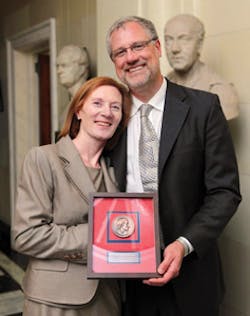Business Forum: Exploiting an unmet demand is a good model for success

With this column, I am beginning a new series of interviews with interesting scientists and engineers who have become successful entrepreneurs in photonics. My first interview is with Henry Kapteyn and Margaret Murnane of KMLabs (Boulder, CO), which has been named the winner of the CLEO/Laser Focus World Innovation Award. (For more on the award-winning product, see http://bcove.me/bhtf0jn0.)
Q: Milton Chang: Let us start by briefly describing your core competencies.
A: Henry Kapteyn/Margaret Murnane: We deliver the highest performance ultrafast light. It is light with the shortest pulse widths, with the cleanest, pedestal-free profile—light confined to only a few optical cycles in duration, focusable to near the diffraction limit. Our cryogenic cooling technology enables ultrafast amplifiers with unprecedented high average powers plus high pulse energy, and also allows for wide, computer-controlled tuning of the pulse rep rate. Our second core competency is in using these lasers as the power source for high-order harmonic upconversion, providing what is in essence the first commercial table-top x-ray lasers.
Q: MC: How did the company get started?
A: HK/MM: It started when we, as two young scientists [a husband-and-wife team], made an unexpected discovery funded by NSF Young Investor and AFOSR Awards. The dream was to use ultrafast lasers to create short bursts of x-rays-fast enough (<10 fs) to capture the fastest motions in materials and molecules, even at the level of electrons. KMLabs came into being when other scientists contacted us, because they wanted the same 10 fs lasers for other applications. So there was a clear demand for very short laser pulses that was not met by existing laser companies.
Q: MC: How did you finance the business initially?
A: HK/MM: We invested $10,000 of our savings as assistant professors into KMLabs to get it started-we have not to date taken outside investment. That allowed us to get a 10 fs laser oscillator business started. Fortunately, we were also able to have parts made in the machine shop of a company started by another professor. High-power ultrafast amplifier systems are much more capital-intensive. For those, we used orders on hand to get a line of credit from the bank. Banking relationships are important, given we have to buy parts to build products that are shipped many months later.
Q: MC: It appears you have done an excellent job in leveraging your research funding. You have worked all that out with your university?
A: HK/MM: Yes, we worked hard to either follow or develop correct procedures to handle disclosures and joint work. This also involves disclosing and having proper oversight through a conflict-of-interest compliance officer. The universities own all IP developed by faculty in their area of research, whether developed by us at JILA [a joint institute of the University of Colorado at Boulder and the National Institute of Standards and Technology] or at KMLabs. We really had terrific experiences with all the universities we have been associated with. Both the University of Michigan and the University of Colorado get royalties from the inventions we made that are now sold by KMLabs.
Q: MC: You were professors without prior business experience. Was either of your parents in business?
A: HK/MM: Margret grew up in Ireland and her father was an elementary school teacher-kindergarten, actually. She had to work to pay for college. My parents emigrated from the Netherlands via Canada and I was born in the Chicago area shortly after they arrived. My father started an industrial control service business. It is definitely the technical nature of my dad's business, as well as his example of starting a self-sustaining independent business that gave me the confidence to start a business.
Q: MC: What is your vision of applications outside of discovery and development?
A: HK/MM: Our business has primarily been supplying advanced lasers for research, but we see this broadening to other uses. By focusing an intense femtosecond pulse into a gas to hit an atom very hard before it even has a chance to ionize, one can generate extremely high-order harmonics to wavelengths less than 8 Å. This is the only practical way to make essentially a table-top coherent x-ray laser, which is useful for everything from imaging for nanotechnology to metrology of thin films—as well as for basic science studies.
Just recently we received some good news—a notice of allowance for our patent on methods for extending the high-harmonic coherent x-ray generation technique to shorter wavelengths into the x-ray region of the spectrum of interest for ultrahigh-resolution x-ray imaging and other nano applications, which is another potential market.
Equivalently, femtosecond lasers are increasingly being used for precision industrial machining because they ablate away material before it has a chance to conduct heat away and cause collateral damage. The result is a clean and precise cut. Another application is precision spectroscopy using ultrashort pulses to generate frequency combs.
Q: MC: Customer handholding must be a challenge.
A: HK/MM: Much of what we have accomplished has been through developing new technologies that are needed by customers to tackle hard scientific problems. Our customers are our source of fulfillment, but can also easily get us into trouble by tempting us with exciting challenges that push the limit! We are now able to make sure we can realistically evaluate the cost of taking on such interesting projects.
Q: MC: Any issue working as a wife-husband team?
A: HK/MM: Being a husband-and-wife team in research is an exceptional advantage—two smart people who trust each other completely can vet ideas quite quickly. We very frequently don't see eye to eye on issues, but the issues where we don't tend much more to be real, substantive ones without a clear answer; i.e., the ones that deserve a good argument.
Regarding family and work issues, we don't really segregate the two. We always feel fortunate that at least we see each other a lot, even when we are working way too hard. This is a generic problem with academe more so, I believe, than in the entrepreneurial world. The tenure clock and academic politics get in the way of family considerations, and ultimately there needs to be a better way.
Q: MC: Ever thought about being part of an established company?
A: HK/MM: There has been considerable consolidation in the laser market, and the time may come when being acquired is appropriate. In the shorter term, our lasers and x-ray lasers are seeing increasing potential use, for example, for metrology in the semiconductor industry. Finding a larger strategic partner to help develop our lasers for industrial application is something we have an active interest in. We feel that with the right partner, we could do much more, accelerate the development of novel, game-changing technologies, and gain greater market penetration.
Q: MC: I have found Boulder has been a good place for Precision Photonics and MBio Diagnostics. What are the pros and cons being in Boulder?
A: HK/MM: Boulder is an exceptional place to establish an advanced R&D intensive company. There are great universities and institutes to collaborate with and hire students from such as the University of Colorado, NIST, the Colorado School of Mines, and Colorado State University. The cost of living is reasonable and the views, hiking, biking, and skiing are spectacular. Moreover, there are many local optics companies, with a very supportive local government.
About the Author
Milton Chang
MILTON CHANG of Incubic Management was president of Newport and New Focus. He is currently director of mBio Diagnostics and Aurrion; a trustee of Caltech; a member of the SEC Advisory Committee on Small and Emerging Companies; and serves on advisory boards and mentors entrepreneurs. Chang is a Fellow of IEEE, OSA, and LIA. Direct your business, management, and career questions to him at [email protected], and check out his book Toward Entrepreneurship at www.miltonchang.com.
